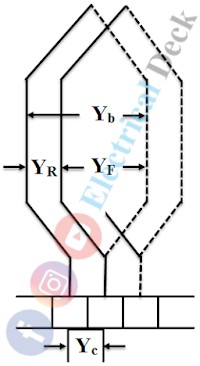Lap Winding :
When the winding is connected in such a manner that the end of the one coil is connected to the starting end of other coils (adjacent coil) of the same pole and so on then the winding is known as lap winding.
Lap winding can be of three types simplex, duplex, and triplex. In simplex lap winding, there are as many parallel paths as there are a number of field poles. The multiplex (duplex or triplex) lap windings are used where heavy currents at low voltage are necessary.
The duplex lap winding is obtained by placing two similar windings on the same armature and connecting the even-numbered commutator bars to one winding and the odd-numbered ones to the second winding.
Important Points Regarding Lap Winding :
- The back and front pitches Yb and Yc should be odd and approximately equal to pole pitch = Z / P. Where,
- Z = number of conductors on the armature
- P = number of ( field ) poles
- Yb should be either greater or less than Yf by 2m. Where,
- m = multiplicity of the winding.
Where,- m = 1 for simplex winding
- m = 2 for duplex winding
- m = 3 for triplex winding
Where Yb is greater than Yf, the winding progresses from left to right and known as Progressive Winding. If Yb is less than Yf, the winding progresses from right to left and is known as retrogressive winding. - The average pitch is given by,
YA = YB + YF / 2
- The resultant pitch Yr is always even, being the difference of two odd numbers Yr = 2 for simplex lap winding (4 and 6 for duplex and triplex respectively).
- The number of slots for 2 layer winding is equal to the number of coils. The number of commutator segments also equal.
- The number of parallel paths equal to the number of poles for simplex winding (and is equal to 2P, 3P, 4P, etc., for duplex, triplex, quadrupled, etc).
- Z = number of conductors on the armature
- P = number of ( field ) poles
- m = multiplicity of the winding.
- m = 1 for simplex winding
- m = 2 for duplex winding
- m = 3 for triplex winding
Wave Winding :
In wave winding, the coil side is not connected back but progresses forward to another coil side. In this way, the winding progresses passing successively every N-pole, S-pole till it returns to the coil side from where it was started.
Because the winding progresses in one direction around the armature in a series of ' waves ', hence it is known as wave winding or series winding.
Important Points Regarding Wave Winding :
- Both Pitches Yb and Yf should be odd and of the same sign.
- Back and front pitches must be nearly equal to the pole pitch and maybe equal or differ by 2 in which case, they will be one more or one less than the average pitch.
- Commutator Pitch,
Yc = Average Pitch Ya
- Resultant Pitch,
Ya = Yf + Yb
- The average Pitch, which must be an even integer is given by,
YA = Z ± 2 / P
Where,
- Z = number of conductors
- P = number of poles
The +ve sign in the above formula will give progressive winding and the -ve sign a retrogressive winding.
- For an even number of pairs of poles i.e., for 2, 4, 6, or 8 pair pole machines :
- The average pitch may be odd or even.
- The number of coils must be odd.
- The number of commutator segments must be odd.
- For odd numbers of pair of poles :
- The number of coils may be even or odd.
- The number of commutator segments may be even or odd.
- If the number of coils is even, Ya must be odd and vice-versa.
- Z = number of conductors
- P = number of poles
- The average pitch may be odd or even.
- The number of coils must be odd.
- The number of commutator segments must be odd.
- The number of coils may be even or odd.
- The number of commutator segments may be even or odd.
- If the number of coils is even, Ya must be odd and vice-versa.
Use of Dummy Coils :
The wave winding is possible only with a particular number of conductors but sometimes the standard armature punchings available in armature winding shops do not meet the requirements of the winding as they may accommodate more than the required number of conductors.
In such cases, dummy (coil or) coils or idle coils are employed. These coils are placed in slots to preserve the balance of the machine but are not electrically connected to the rest of the winding.



